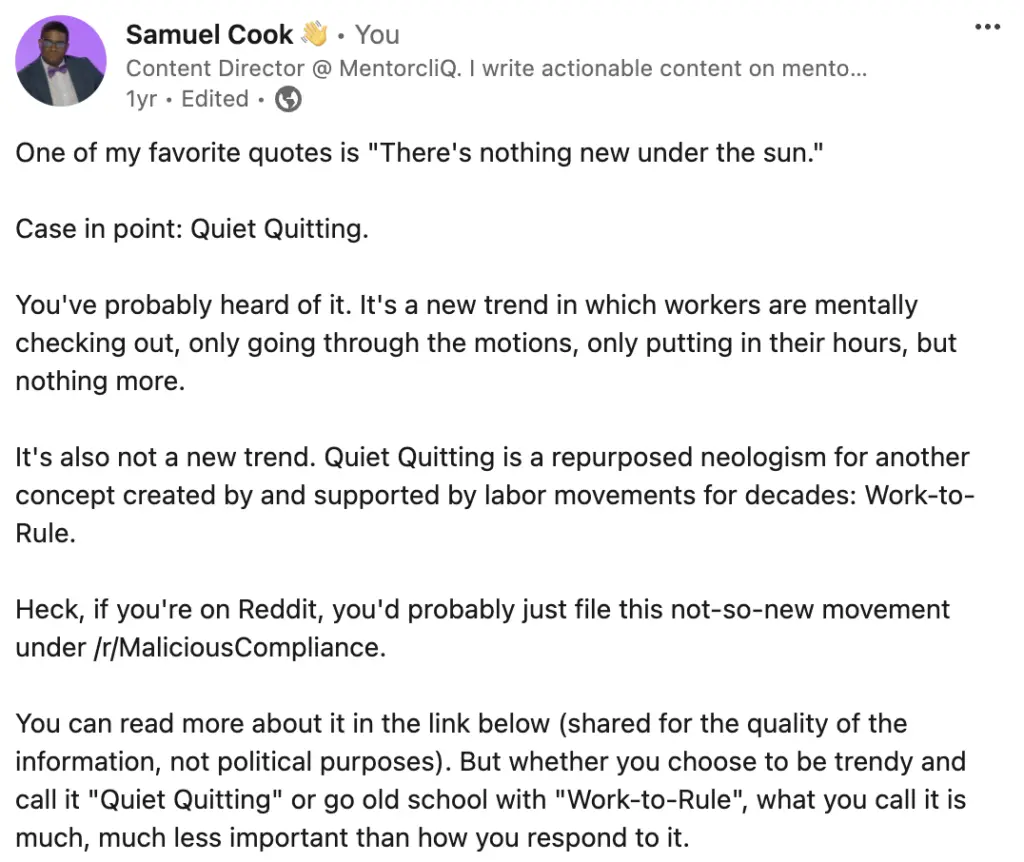There’s a new word for low employee engagement making the rounds these days: “quiet quitting”. Tracing the origin of the word may be a practice in futility (one of the earliest we found was a YouTube video on quiet quitting the teaching profession published on June 24, 2022), but knowing exactly where it started is much less important the understanding why it’s taking flight, and what it means for companies, and how to respond to it. Simply put, quiet quitting is a consequence of low employee engagement, and without the right response, employers are at risk of taking a major hit to productivity and profitability.
Quiet Quitting: An Employee Engagement Crisis With a New Name
Quiet Quitting is the act of mentally checking out of work by only doing the bare minimum of what’s required according to the job contract. That can seem a lot less severe than it sounds, but the reality for most companies is that “bare minimum” engagement by employees usually leads to decreased productivity, reduced revenue, and increased turnover.
As my colleague Sam Cook, MentorcliQ Content Strategist also noted in a recent LinkedIn Post, Quiet Quitting isn’t a new concept. It’s a rebranding of labor movement work-to-rule practices.

And according to other observers, “Quiet Quitting” is just Gen Z TikTokers take on work-life balance.
Quiet Quitting Comes at a High Cost
Regardless of the many names available to it, Quiet Quitting is also devastating to workplace culture. It involves a burnt-out employee sticking around and settling on the minimum of what needs to be done, rather than feeding their growth mindsets to pursue interesting projects, problem-solving opportunities, and participating in rewarding team activities.
How costly are we talking about? According to Gallup, as much as 2X an employee’s salary. That includes the much higher cost of recruiting new talent, which you may end up paying a 25% premium on compared to the worker who left.
To put that into perspective, the Bureau of Labor Statistics reports that in June 2022, the average number of people quitting jobs in the Professional and Business Services industry was more than double the number of layoffs, at 3.3 people (per 100) versus 1.5 for layoffs.
Assuming those employees who voluntarily needed to quit also need to be replaced, and assuming they earn an average salary of around $74,000 (according to BLS wage data), it would cost employers as much as $444,000 to replace those three workers.
That’s a huge expense and likely not one most companies are eager to absorb compared to the much cheaper cost of retaining those employees.
That, of course, only accounts for people who are fully quitting. Quiet Quitting means they’re still around, but actively disengaged. That, too, comes at a high cost. Disengagement and lower productivity can cost companies around $6,000 per employee per year.
Gallup reports that only 32% of employees were actively engaged as of early 2022, and 17% were actively disengaged. Conservatively, with 17 out of every 100 employees actively disengaged, companies are losing $102,000 per year or much more due to decreased engagement for every 100 employees. For large companies with at least 1,000 employees, the numbers multiply to over $1 million per year in lost productivity. Ouch.
It’s clear that Quiet Quitting isn’t just an engagement crisis. It’s a crisis at the very foundation of what allows businesses to thrive.
Mentoring Re-Awakens Employee Engagement
If preventing or remedying burnout is essential to preventing Quiet Quitting, low employee engagement, and the eventual high turnover that follows organizations need an easy-to-access employee benefit that isn’t one size fits all and can address the work stresses leading to burnout.
An intentional mentoring program accessible to all employees is key to preventing and addressing Quiet Quitting. Mentoring brings to the forefront burnout tendencies in a safe, conversational environment to help employees label their feelings, understand them, and come up with alternative perspectives or approaches.
Take for example these 4 reasons employees give up:
1. Dwelling on mistakes: Mistakes can be hard to process. The power of negativity tells us that a negative will imprint in our brain far easier than a positive. For this reason, people need to hear a positive message more than a negative in order to balance our natural psychology. That means being told more than once that a mistake is meant to be learned from and not the end of the world. Hopefully, employees are hearing that from their teams and managers, but a mentor is yet another trusted advisor who can emphasize that message.
2. Not visualizing what’s possible: What’s possible in an employee’s career trajectory might come up in an annual performance review, or a bi-annual one-on-one with a manager. But risking a year without an employee looking to the future means 364 days of rote, day-to-day processes that are tedious and boring. Mentoring relationships add this key layer of engagement by focusing on what’s possible, identifying gaps to get there, and working together to achieve goals on a more regular basis.
3. Assuming problems are unique: Employees who think their problems are unique are going to question their fit for their role and their future at the organization. The only way for us to know that our problems aren’t unique is by someone else sharing their vulnerable mistakes with us. While an employee won’t always feel comfortable sharing their problems with their direct manager or team out of concerns of judgment, a mentor offers a welcoming ear and space to hear that our problems are not unique, and that there’s a way to move on from them.
4. Believing they’re not valued: There are many reasons why employees may feel undervalued. Believe it or not, pay is not the top reason. According to McKinsey, the top factor driving attrition is inadequate career development and advancement. When people feel stuck in their careers, they check out. And if they check out long enough, they quit. Conversely, mentoring prioritizes those needs by making them people-centric, tangible, and immediately accessible.

If you’re looking to prevent Quiet Quitting, don’t settle for a “pull yourself up by your bootstraps” approach. Increasing social connections and real conversations, especially in a virtual world, can reinvigorate your employees, enhance their feelings of purpose, and inspire them to look forward to what they have next in store!
Mentoring is one of the most cost-effective and simplest ways to put employee connection back on the forefront. Even as we face an engagement recession unlike anything we’ve seen before, companies can make the right steps by shifting to a people-first approach.
Here are two steps you can take today to solve Quiet Quitting:
- Download our 2022 / Survival Guide (Great Resignation Toolkit) to learn more about why employees are checking out and what you can do about it.
- Contact us today to learn more about how mentoring software can help re-awaken your employee engagement.
Take action now to reap the benefits of lower turnover and high engagement, even during uncertain times like these.




